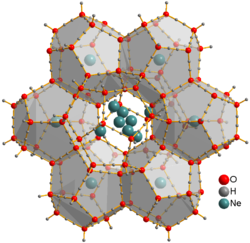Neon
Neon is a chemical element on the periodic table. It is part of the noble gas group and it has an atomic number of 10. It is an odorless and tasteless gas (at 15 degrees Celsius at standard pressure).
 | |||||||||||||||||||||
| General properties | |||||||||||||||||||||
|---|---|---|---|---|---|---|---|---|---|---|---|---|---|---|---|---|---|---|---|---|---|
| Appearance | colorless gas exhibiting an orange-red glow when placed in an electric field | ||||||||||||||||||||
| Standard atomic weight (Ar, standard) | 20.1797(6)[1] | ||||||||||||||||||||
| Neon in the periodic table | |||||||||||||||||||||
| |||||||||||||||||||||
| Atomic number (Z) | 10 | ||||||||||||||||||||
| Group | group 18 (noble gases) | ||||||||||||||||||||
| Period | period 2 | ||||||||||||||||||||
| Block | p-block | ||||||||||||||||||||
| Element category | noble gas | ||||||||||||||||||||
| Electron configuration | [He] 2s2 2p6 | ||||||||||||||||||||
Electrons per shell | 2, 8 | ||||||||||||||||||||
| Physical properties | |||||||||||||||||||||
| Phase at STP | Ne: Gas | ||||||||||||||||||||
| Melting point | 24.56 K (−248.59 °C, −415.46 °F) | ||||||||||||||||||||
| Boiling point | 27.104 K (−246.046 °C, −410.883 °F) | ||||||||||||||||||||
| Density (at STP) | 0.9002 g/L | ||||||||||||||||||||
| when liquid (at b.p.) | 1.207 g/cm3[2] | ||||||||||||||||||||
| Triple point | 24.556 K, 43.37 kPa[3][4] | ||||||||||||||||||||
| Critical point | 44.4918 K, 2.7686 MPa[4] | ||||||||||||||||||||
| Heat of fusion | 0.335 kJ/mol | ||||||||||||||||||||
| Heat of vaporization | 1.71 kJ/mol | ||||||||||||||||||||
| Molar heat capacity | 20.79[5] J/(mol·K) | ||||||||||||||||||||
Vapor pressure
| |||||||||||||||||||||
| Atomic properties | |||||||||||||||||||||
| Oxidation states | 0 | ||||||||||||||||||||
| Ionization energies |
| ||||||||||||||||||||
| Covalent radius | 58 pm | ||||||||||||||||||||
| Van der Waals radius | 154 pm | ||||||||||||||||||||
| Spectral lines of neon | |||||||||||||||||||||
| Other properties | |||||||||||||||||||||
| Natural occurrence | Ne: Primordial | ||||||||||||||||||||
| Crystal structure | face-centered cubic (fcc) | ||||||||||||||||||||
| Speed of sound | 435 m/s (gas, at 0 °C) | ||||||||||||||||||||
| Thermal conductivity | 49.1×10−3 W/(m·K) | ||||||||||||||||||||
| Magnetic ordering | diamagnetic[6] | ||||||||||||||||||||
| Magnetic susceptibility | −6.74·10−6 cm3/mol (298 K)[7] | ||||||||||||||||||||
| Bulk modulus | 654 GPa | ||||||||||||||||||||
| CAS Number | 7440-01-9 | ||||||||||||||||||||
| History | |||||||||||||||||||||
| Prediction | William Ramsay (1897) | ||||||||||||||||||||
| Discovery and first isolation | William Ramsay & Morris Travers[8][9] (1898) | ||||||||||||||||||||
| Main isotopes of neon | |||||||||||||||||||||
| |||||||||||||||||||||
Neon does not react with other elements, so it is found by itself. There is not much neon in the air, and it is clear, so we do not see it.
It was previously thought that Neon could not bond with any other elements, creating compounds. However, there have been a few compounds that have been made with neon, such as NeAuF and NeBeS.
History
Two British scientists, Sir William Ramsay and Morris Travers, discovered neon, argon, krypton, and xenon. Together they discovered a brand new gas element in 1898. Four years before, Ramsay, a physical chemist, had found argon and was the first person to isolate helium in 1895. The scientists froze argon, using liquid air, and then evaporated this to collect the gas that is produced. Using a high voltage, they collected the first sample of the gas. To their surprise, the gas illuminated the glass tubes and glowed with bright crimson light.[10]
Upon discovery, the two scientists decided to name the new gas Neon, after the Greek word Neos, meaning the new one. While Ramsay and Travers discovered neon gas, they didn’t invent neon lamps. It wasn’t until 1902 when French engineer and inventor Georges Claude showcased the first neon light.
Uses
Neon gas is used in gas discharge lamps. When electricity goes through the neon, it lights up red. Due to this quality, it is used in light up signs. Similar signs use other gases to make other colors, but they are also often called "neon signs". Neon is also a term referring to a type of color that is very bright, such as lime green.
Neon Media
The first evidence for isotopes of a stable element was provided in 1913 by experiments on neon plasma. In the bottom right corner of J. J. Thomson's photographic plate are the separate impact marks for the two isotopes neon-20 and neon-22.
The emission spectrum of neon shows individual wavelengths of light contributing to its perceived colour when heated.
Related pages
References
- ↑ Meija, J.; Coplen, T. B.; Berglund, M.; Brand, W.A.; De Bièvre, P.; Gröning, M.; Holden, N.E.; Irrgeher, J.; Loss, R.D.; Walczyk, T.; Prohaska, T. (2016). "Atomic weights of the elements 2013 (IUPAC Technical Report)". Pure and Applied Chemistry. 88 (3): 265–91. doi:10.1515/pac-2015-0305.
{{cite journal}}: Unknown parameter|displayauthors=ignored (|display-authors=suggested) (help) - ↑ Hammond, C. R. (2000). The Elements, in Handbook of Chemistry and Physics 81st edition (PDF). CRC press. p. 19. ISBN 0849304814.
- ↑ Preston-Thomas, H. (1990). "The International Temperature Scale of 1990 (ITS-90)". Metrologia. 27: 3–10. Bibcode:1990Metro..27....3P. doi:10.1088/0026-1394/27/1/002.
- ↑ 4.0 4.1 Haynes, William M., ed. (2011). CRC Handbook of Chemistry and Physics (92nd ed.). Boca Raton, FL: CRC Press. p. 4.122. ISBN 1439855110.
- ↑ Shuen-Chen Hwang, Robert D. Lein, Daniel A. Morgan (2005). "Noble Gases". Kirk Othmer Encyclopedia of Chemical Technology. Wiley. pp. 343–383. doi:10.1002/0471238961.0701190508230114.a01.
- ↑ Magnetic susceptibility of the elements and inorganic compounds, in Lide, D. R., ed. (2005). CRC Handbook of Chemistry and Physics (86th ed.). Boca Raton (FL): CRC Press. ISBN 0-8493-0486-5.
- ↑ Weast, Robert (1984). CRC, Handbook of Chemistry and Physics. Boca Raton, Florida: Chemical Rubber Company Publishing. pp. E110. ISBN 0-8493-0464-4.
- ↑ Ramsay, William; Travers, Morris W. (1898). "On the Companions of Argon". Proceedings of the Royal Society of London. 63 (1): 437–440. doi:10.1098/rspl.1898.0057.
- ↑ "Neon: History". Softciências. Retrieved 2007-02-27.
- ↑ Mama, Neon. "The History Of Neon Signs and Lights". Neon Mama. Archived from the original on 2022-05-27. Retrieved 2022-03-23.





